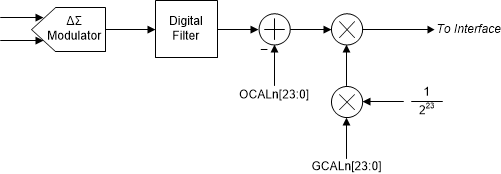ZHCSN79 September 2021 ADS131B02-Q1
PRODUCTION DATA
- 1 特性
- 2 应用
- 3 说明
- 4 Revision History
- 5 Pin Configuration and Functions
- 6 Specifications
- 7 Parameter Measurement Information
-
8 Detailed Description
- 8.1 Overview
- 8.2 Functional Block Diagram
- 8.3 Feature Description
- 8.4 Device Functional Modes
- 8.5
Programming
- 8.5.1
Serial Interface
- 8.5.1.1 Chip Select (CS)
- 8.5.1.2 Serial Data Clock (SCLK)
- 8.5.1.3 Serial Data Input (DIN)
- 8.5.1.4 Serial Data Output (DOUT)
- 8.5.1.5 Data Ready (DRDY)
- 8.5.1.6 SPI Communication Frames
- 8.5.1.7 SPI Communication Words
- 8.5.1.8 Short SPI Frames
- 8.5.1.9 Communication Cyclic Redundancy Check (CRC)
- 8.5.1.10 SPI Timeout
- 8.5.2 ADC Conversion Data Format
- 8.5.3 Commands
- 8.5.4 Collecting Data for the First Time or After a Pause in Data Collection
- 8.5.1
Serial Interface
- 8.6 Register Map
- 9 Application and Implementation
- 10Power Supply Recommendations
- 11Layout
- 12Device and Documentation Support
- 13Mechanical, Packaging, and Orderable Information
8.3.9 Calibration Registers
The calibration registers allow for the automatic computation of calibrated ADC conversion results from preprogrammed values. The host can rely on the device to automatically correct for system gain and offset after the error correction terms are programmed into the corresponding device registers. The measured calibration coefficients must be store in external non-volatile memory and programmed into the registers each time the ADS131B02-Q1 powers up or resets because the ADS131B02-Q1 registers are volatile.
The offset calibration registers are used to correct for system offset error, otherwise known as zero error. Offset error corresponds to the ADC output when the input to the system is zero. The ADS131B02-Q1 corrects for offset errors by subtracting the contents of the OCALn[23:0] register bits in the CHn_OCAL_MSB and CHn_OCAL_LSB registers from the conversion result for that channel before being output. There are separate CHn_OCAL_MSB and CHnOCAL_LSB registers for each channel, which allows separate offset calibration coefficients to be programmed for each channel. The contents of the OCALn[23:0] bits are interpreted by the device as 24-bit two's complement values, which is the same format as the ADC data.
The gain calibration registers are used to correct for system gain error. Gain error corresponds to the deviation of gain of the system from its ideal value. The ADS131B02-Q1 corrects for gain errors by multiplying the ADC conversion result by the value given by the contents of the GCALn[23:0] register bits in the CHn_GCAL_MSB and CHn_GCAL_LSB registers before being output. There are separate CHn_GCAL_MSB and CHn_GCAL_LSB registers for each channel, which allows separate gain calibration coefficients to be programmed for each channel. The contents of the GCALn[23:0] bits are interpreted by the device as 24-bit unsigned values corresponding to linear steps ranging from gains of 0 to 2 – (1 / 223). Table 8-6 describes the relationship between the GCALn[23:0] bit values and the gain calibration factor.
| GCALn[23:0] VALUE | GAIN CALIBRATION FACTOR |
|---|---|
| 000000h | 0 |
| 000001h | 1.19 × 10–7 |
| 800000h | 1 |
| FFFFFEh | 2 – 2.38 × 10–7 |
| FFFFFFh | 2 – 1.19 × 10–7 |
The calibration registers do not need to be enabled because they are always in use. The OCALn[23:0] bits have a default value of 000000h resulting in no offset correction. Similarly, the GCALn[23:0] bits default to 800000h resulting in a gain calibration factor of 1.
Figure 8-9 shows a block diagram illustrating the mechanics of the calibration registers on one channel of the ADS131B02-Q1.
 Figure 8-9 Calibration Block
Diagram
Figure 8-9 Calibration Block
Diagram